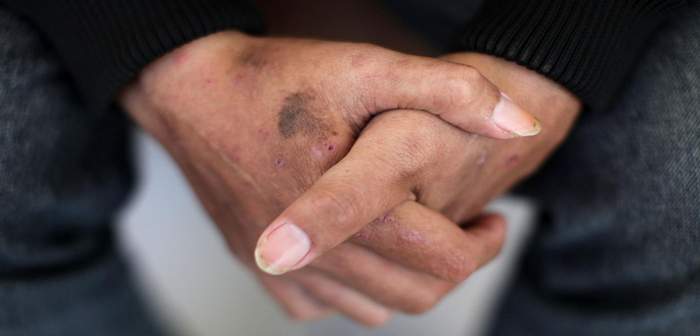What's in this article?
Men Greatly Affected by New HIV Infections
According to the Centers for Disease Control and Prevention (CDC), over one million people aged 13 and older were living with an HIV infection in the United States at the end of 2009. Gay and bisexual men make up nearly two-thirds of the 50,000 newly infected each year. Black/African American men and women are also greatly affected.
Early treatment is key to a long life, but some men experience no symptoms.
How to spot early HIV symptoms in men
In general, the HIV symptoms that men will experience are not all that different to those found in women. Apart from vaginal or menstrual changes all the tell-tale signs are the same in men and women.
HIV symptoms can vary significantly between patients. No two HIV-positive men will have exactly the same experience.
In general, a man’s HIV infection will follow this general pattern:
- Acute illness: This may or may not occur. Around 70% of patients notice it. If this occurs, it is most liekly to happen 1-2 weeks post infection. Symptoms include fever, sickness and chills.
- Asymptomatic period: A long period of time (up to 10 years) in which you do not experience any symptoms.
- Advanced infection: A highly weakened immune system makes you susceptible to a number of different illnesses.
If you think you may have been exposed to HIV, get an HIV test. Most HIV tests detect antibodies (proteins your body makes as a reaction against the presence of HIV), not HIV itself. But it takes a few weeks for your body to produce these antibodies, so if you test too early, you might not get an accurate test result. A new HIV test is available that can detect HIV directly during this early stage of infection. So be sure to let your testing site know if you think you may have beenrecently infected with HIV.
After you get tested, it’s important to find out the result of your test so you can talk to your health care provider about treatment options if you’re HIV-positive or learn ways to prevent getting HIV if you’re HIV-negative.
You are at high risk of transmitting HIV to others during the early stage of HIV infection, even if you have no symptoms. For this reason, it is very important to take steps to reduce your risk of transmission.
HIV Rash Symptoms
An individual who tests positive for HIV may see what is often referred to as the HIVrash. At some point during the illness, at least 85% of HIV victims will have this rash. The symptoms occur around 2 to 4 weeks after a person is infected. But it should be noted that rash symptoms do not always occur in individual infected with HIV and having a rash does not mean that HIV has been contracted. Rashes are very common and can be caused by many diverse reasons.
An HIV rash can look frightful, but physicians say it is not a cause for concern. An individual should speak with their physician if skin ulcers develop which can cause bacteria infection. There are other rashes that are common for instance heat rash, eczema as well as rashes due to stress so it is important to not get into a stage of panic.
Signs and symptoms of this HIV rash includes:
- Brown or red razor skin bumps resembling eczema. Bumps are dark red and brown in individuals with light skin while in those having dark skin; these bumps are dark purple and black.
- Rashes affect any part of body, but develop mostly on areas such as the face, hands, feet as well as trunk.
- Some individuals may experience blisters in the moist regions of the body such as mouth, genitals as well as eyes.
- Folliculitis, pimples as well as acne may occur around follicles of hair on most skin areas of the body.
- Rashes may also itch in some individuals.
- Additional acute symptoms include skin peeling that can cause blisters as well as sores in the areas of the genitals.
- Individuals with rashes are also likely to develop fever, diarrhea, headaches, decease in weight as well as vision problems.
- Swollen glands, muscle pains and aches, loss of memory, extreme fatigues, painful and stiff joints as well as regular fevers that are not explainable.
- Herpes virus infection can cause the symptoms of HIV rashes to worsen especially in individuals at the advanced stage of HIV. Characterized by red rashes that appear as fluid-filled blisters especially with individuals with weakened immune system.
- Other Skin rashes include
- Molluscum contagiosum
- HPV warts
- Tinea
- Scabies
- Psoriasis
- Hives
- Eosinophilic follicutitis
Often during the 3rd stage of HIV which is known as symptomatic HIV, rashes which are more concentrated may occur. This is the stage of HIV which lasts from 1 to 3 years and occurs before full AIDS develops. The rashes throughout this stage are pink and often scaly. This form of HIV rash may show up on the scalp, face, armpit, chest as well as groin. It is imperative for individuals with HIV to take care of their health as well as the immune system to be able to defend against infections or complications.
Symptoms Of An Advanced HIV Infection
It may take a number of weeks, months or years, but the HIV infection will eventually break down your immune system. This weakened immune system leaves the body susceptible to attack by so called ‘opportunistic infections.’ These are conditions that your body would normally be able to fight off, but which can prove fatal in HIV-positive individuals.
You may notice:
- Recurrent fungal infections such as fungal nail infections that will not go away or respond to over-the-counter medication
- Recurrent colds, flu and viruses
- Dementia, confusion and impaired motor skills
What Should I Do If I Notice HIV Symptoms?
If you do start noticing any of the early symptoms of HIV, and you have put yourself at risk of HIV infection then you need to get tested.
You need to wait for a sufficient number of antibodies to build up in your system for an accurate result. This takes about 1 – 3 months.
You can ask your doctor for a viral load test (which will detect any HIV circulating in your blood stream) but these are rarely used in HIV testing. These tests are very sensitive and have a tendency of showing up false-positives, so if you take the test and this happens to you, you will be referred for an HIV antibody test to confirm your status.
The 4th Generation (antigen/ antibody) test is the most commonly used HIV test used in the UK. It can give an accurate result from 4 weeks after exposure.
HIV treatment
HIV treatment guidelines recommend that all people with HIV should take HIV treatment. The sooner you start to take HIV treatment, the sooner you can benefit from it.
Moreover, some doctors believe there may be additional advantages to starting HIV treatment in the first few months after contracting HIV. It may have a long-term benefit by helping preserve the body’s natural ability to fight HIV and by limiting the spread of HIV in the body. Treatment will also lower the risk of passing HIV on during a period in which people are unusually infectious (see below).
Your doctor may strongly recommend starting treatment now:
- If you have an AIDS-defining illness
- If your nervous system (brain, spine and nerves) are affected by HIV
- If you have a CD4 cell count below 350
- If you had an HIV-negative test result less than 12 weeks before being diagnosed with HIV.
If you are in this situation, there may be some pressure to make a decision quickly. Nonetheless you should only start treatment if you feel ready to do so. If you feel that you need time to come to terms with having HIV or to understand what treatment involves, you don’t need to start straightaway.
Talk to Your Doctor
Though a rash is uncomfortable, it can be useful in helping your doctor to identify and diagnose an HIV infection. Talk to your doctor right away if you notice skin changes or if you experience itchiness, redness, or discomfort. You can take steps to manage the condition and improve your quality of life.






Leave a Comment